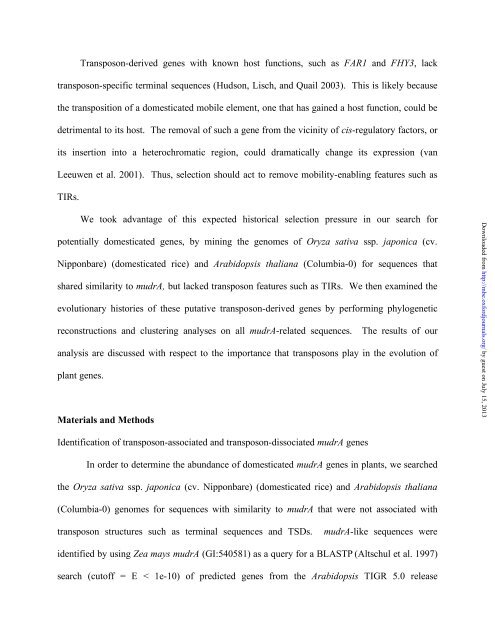MUSTANG is a novel family of domesticated transposase genes ...
MUSTANG is a novel family of domesticated transposase genes ...
MUSTANG is a novel family of domesticated transposase genes ...
You also want an ePaper? Increase the reach of your titles
YUMPU automatically turns print PDFs into web optimized ePapers that Google loves.
Transposon-derived <strong>genes</strong> with known host functions, such as FAR1 and FHY3, lack<br />
transposon-specific terminal sequences (Hudson, L<strong>is</strong>ch, and Quail 2003). Th<strong>is</strong> <strong>is</strong> likely because<br />
the transposition <strong>of</strong> a <strong>domesticated</strong> mobile element, one that has gained a host function, could be<br />
detrimental to its host. The removal <strong>of</strong> such a gene from the vicinity <strong>of</strong> c<strong>is</strong>-regulatory factors, or<br />
its insertion into a heterochromatic region, could dramatically change its expression (van<br />
Leeuwen et al. 2001). Thus, selection should act to remove mobility-enabling features such as<br />
TIRs.<br />
We took advantage <strong>of</strong> th<strong>is</strong> expected h<strong>is</strong>torical selection pressure in our search for<br />
potentially <strong>domesticated</strong> <strong>genes</strong>, by mining the genomes <strong>of</strong> Oryza sativa ssp. japonica (cv.<br />
Nipponbare) (<strong>domesticated</strong> rice) and Arabidops<strong>is</strong> thaliana (Columbia-0) for sequences that<br />
shared similarity to mudrA, but lacked transposon features such as TIRs. We then examined the<br />
evolutionary h<strong>is</strong>tories <strong>of</strong> these putative transposon-derived <strong>genes</strong> by performing phylogenetic<br />
reconstructions and clustering analyses on all mudrA-related sequences. The results <strong>of</strong> our<br />
analys<strong>is</strong> are d<strong>is</strong>cussed with respect to the importance that transposons play in the evolution <strong>of</strong><br />
plant <strong>genes</strong>.<br />
Materials and Methods<br />
Identification <strong>of</strong> transposon-associated and transposon-d<strong>is</strong>sociated mudrA <strong>genes</strong><br />
In order to determine the abundance <strong>of</strong> <strong>domesticated</strong> mudrA <strong>genes</strong> in plants, we searched<br />
the Oryza sativa ssp. japonica (cv. Nipponbare) (<strong>domesticated</strong> rice) and Arabidops<strong>is</strong> thaliana<br />
(Columbia-0) genomes for sequences with similarity to mudrA that were not associated with<br />
transposon structures such as terminal sequences and TSDs. mudrA-like sequences were<br />
identified by using Zea mays mudrA (GI:540581) as a query for a BLASTP (Altschul et al. 1997)<br />
search (cut<strong>of</strong>f = E < 1e-10) <strong>of</strong> predicted <strong>genes</strong> from the Arabidops<strong>is</strong> TIGR 5.0 release<br />
Downloaded from<br />
http://mbe.oxfordjournals.org/<br />
by guest on July 15, 2013











